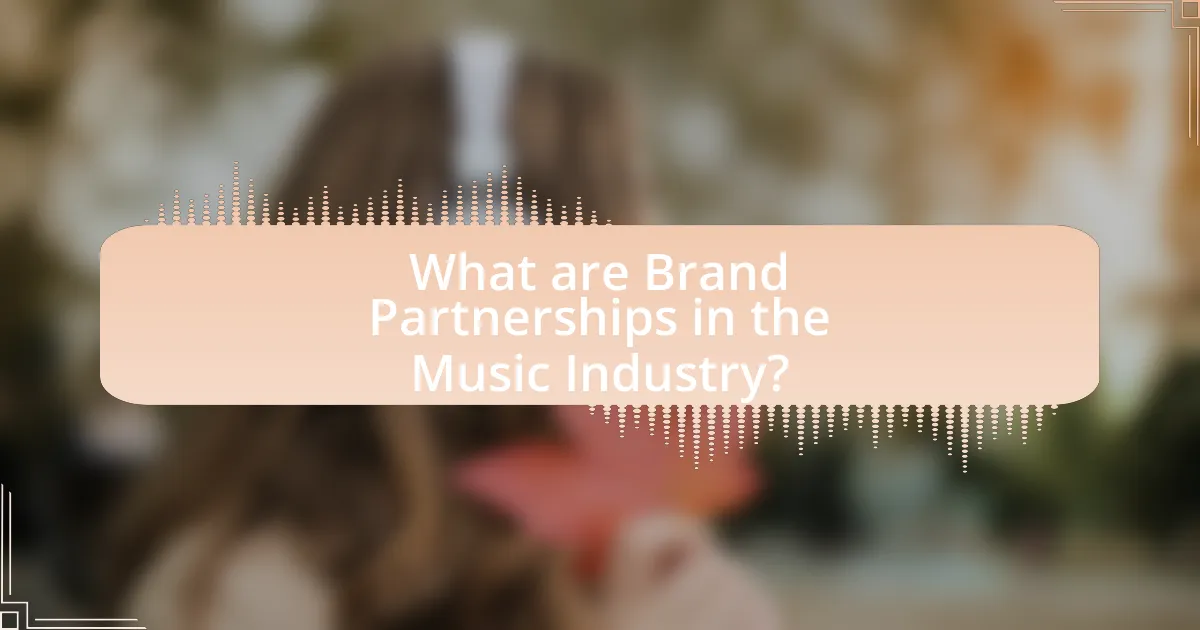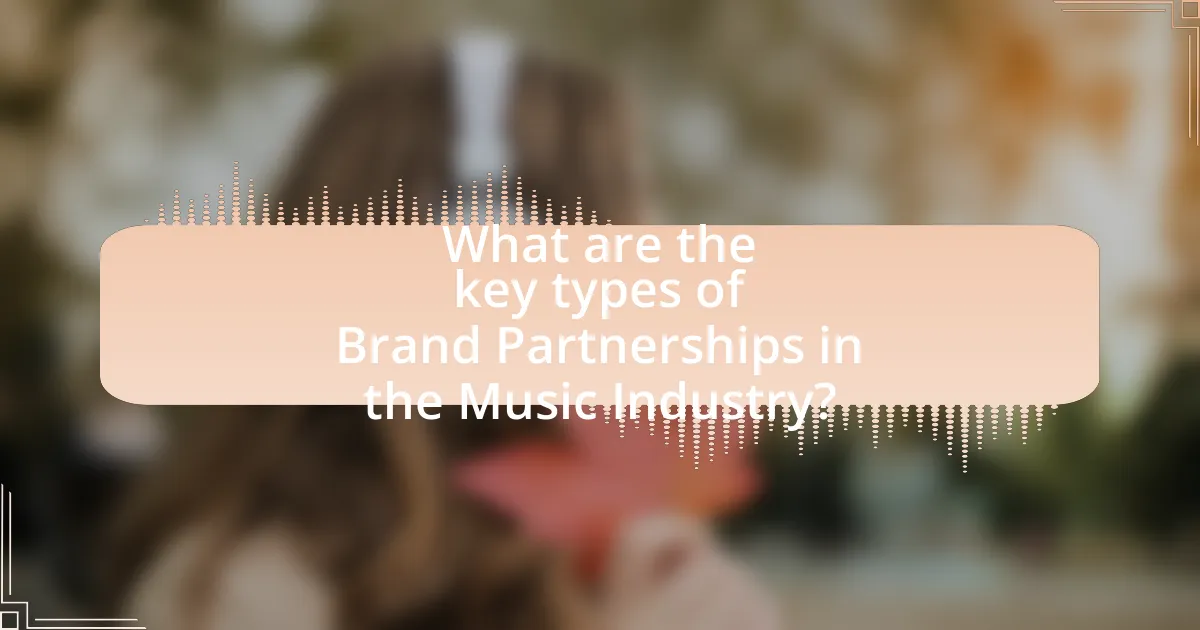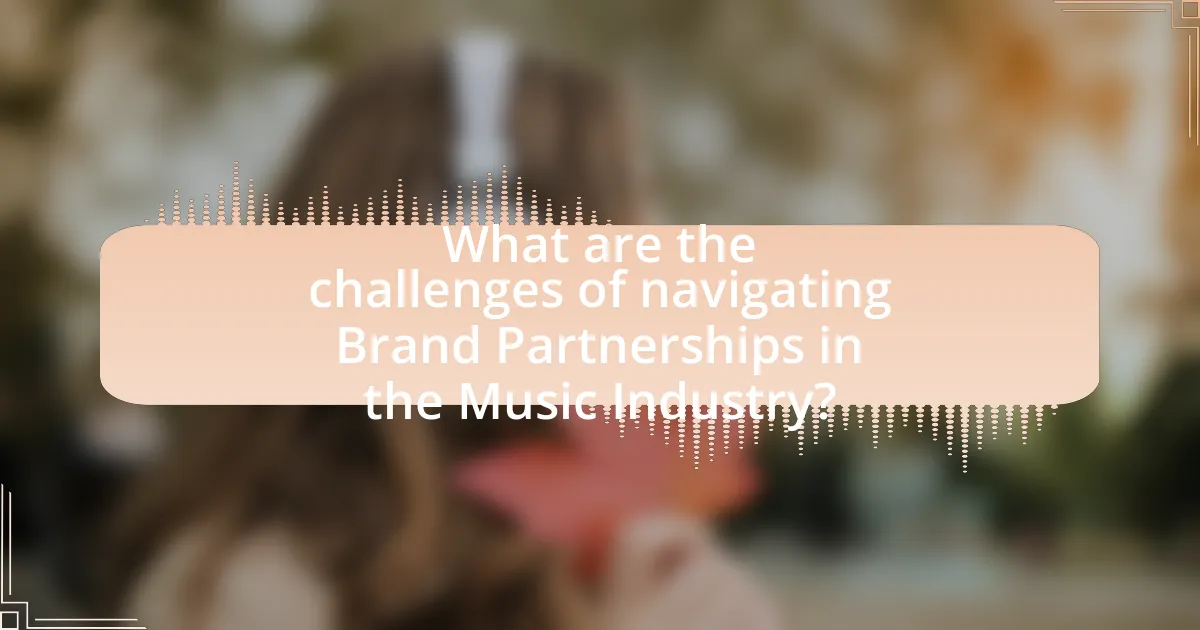Brand partnerships in the music industry refer to collaborative agreements between music artists and brands aimed at promoting products or services. These partnerships leverage the artist’s influence to enhance brand visibility through co-branded marketing campaigns, sponsorships, and exclusive content. The article explores how these partnerships function within the music ecosystem, the roles of artists and brands, and their impact on music marketing strategies. It also discusses the importance of alignment in values, the various types of partnerships, and the challenges faced in navigating these collaborations, providing insights into best practices for successful outcomes. Key metrics for evaluating the success of brand partnerships are also outlined, emphasizing their significance in driving revenue and audience engagement.

What are Brand Partnerships in the Music Industry?
Brand partnerships in the music industry are collaborative agreements between music artists or entities and brands to promote products or services. These partnerships leverage the artist’s influence and fan base to enhance brand visibility and engagement, often resulting in co-branded marketing campaigns, sponsorships, or exclusive content. For instance, a notable example is the partnership between Pepsi and major music festivals, which not only boosts the festival’s profile but also aligns Pepsi with popular music culture, thereby reaching a wider audience.
How do Brand Partnerships function within the music ecosystem?
Brand partnerships within the music ecosystem function by aligning brands with artists and music events to enhance visibility and engagement. These partnerships leverage the artist’s fan base and cultural relevance to create authentic marketing opportunities, such as sponsored concerts, exclusive merchandise, and collaborative content. For instance, brands like Pepsi and Red Bull have successfully partnered with major music festivals, increasing their brand exposure while providing financial support to artists and events. This symbiotic relationship benefits both parties: brands gain access to targeted audiences, while artists receive funding and promotional support, ultimately driving revenue and brand loyalty.
What roles do artists and brands play in these partnerships?
Artists serve as creative influencers and cultural ambassadors in partnerships, while brands provide financial support and marketing reach. Artists leverage their unique artistic expression and fan engagement to enhance brand visibility, often aligning their image with the brand’s values. Brands, in turn, utilize the artist’s popularity to access new audiences and create authentic connections, as evidenced by collaborations like Nike’s partnership with Travis Scott, which resulted in significant sales increases and heightened brand loyalty.
How do brand partnerships influence music marketing strategies?
Brand partnerships significantly enhance music marketing strategies by providing artists and labels with increased visibility and access to new audiences. These collaborations often leverage the established customer bases of brands, allowing musicians to reach potential fans who may not be familiar with their work. For instance, a partnership between a popular beverage brand and a music artist can result in co-branded campaigns that generate buzz and engagement across multiple platforms, such as social media and live events.
Moreover, research indicates that 70% of consumers are more likely to purchase a product when it is associated with a music artist they admire, demonstrating the effectiveness of these partnerships in driving sales and brand loyalty. Additionally, brands often invest in exclusive content, such as music videos or behind-the-scenes footage, which can further amplify an artist’s reach and enhance their marketing efforts. Thus, brand partnerships serve as a strategic tool in music marketing, fostering mutual benefits for both artists and brands.
Why are Brand Partnerships important for artists and brands?
Brand partnerships are important for artists and brands because they create mutually beneficial opportunities that enhance visibility and revenue. For artists, collaborations with brands can lead to increased exposure to new audiences, as brands often have established marketing channels and customer bases. For example, a partnership with a well-known beverage company can introduce an emerging artist to millions of potential fans through advertising campaigns and events.
Simultaneously, brands benefit from associating with artists who resonate with their target demographics, allowing them to enhance their brand image and reach. According to a study by Nielsen, 66% of consumers are more likely to purchase a product if it is endorsed by a celebrity or influencer they admire. This statistic underscores the effectiveness of brand partnerships in driving consumer engagement and sales. Thus, the synergy created through these partnerships is essential for both artists and brands in the competitive landscape of the music industry.
What benefits do artists gain from collaborating with brands?
Artists gain increased visibility and financial support from collaborating with brands. These partnerships often provide artists with access to larger audiences through brand marketing channels, enhancing their reach and fan engagement. For instance, a study by Nielsen found that 70% of consumers feel more connected to brands that partner with artists, indicating that such collaborations can significantly boost an artist’s public profile. Additionally, financial backing from brands can enable artists to fund projects, tours, and promotional activities, ultimately leading to greater creative freedom and opportunities for growth in their careers.
How do brands enhance their visibility through music partnerships?
Brands enhance their visibility through music partnerships by leveraging the emotional connection and broad reach of music to engage audiences. Collaborating with artists allows brands to tap into their fan bases, creating authentic experiences that resonate with consumers. For instance, a study by Nielsen found that 70% of millennials are more likely to remember a brand that partners with a music artist they like, demonstrating the effectiveness of such collaborations in increasing brand recall. Additionally, music events and sponsorships provide brands with platforms to showcase their products in a lively environment, further amplifying their visibility and engagement with potential customers.

What are the key types of Brand Partnerships in the Music Industry?
The key types of brand partnerships in the music industry include sponsorships, collaborations, and licensing agreements. Sponsorships involve brands financially supporting artists or events in exchange for promotional opportunities, such as logo placements at concerts or festivals. Collaborations occur when artists and brands work together on projects, such as co-branded merchandise or exclusive music releases, enhancing both parties’ visibility and reach. Licensing agreements allow brands to use an artist’s music in advertisements, films, or other media, providing artists with revenue while promoting the brand. These partnership types are essential for driving revenue and expanding audience engagement in the music industry.
What are the different models of Brand Partnerships?
The different models of Brand Partnerships include sponsorships, co-branding, affiliate marketing, and brand licensing. Sponsorships involve brands financially supporting events or artists in exchange for promotional opportunities, which is common in the music industry where brands seek visibility at concerts or festivals. Co-branding occurs when two brands collaborate on a product or campaign, leveraging each other’s strengths to reach a wider audience; for example, a beverage company partnering with a popular artist to create a limited-edition drink. Affiliate marketing allows brands to promote products through artists or influencers, earning commissions on sales generated from their referrals, which is increasingly utilized in digital music platforms. Brand licensing permits brands to use an artist’s name or image for promotional purposes, often seen in merchandise collaborations. Each model serves distinct strategic purposes, enhancing brand visibility and engagement within the music sector.
How do sponsorships differ from endorsements in music?
Sponsorships in music involve a brand providing financial support or resources to an artist or event in exchange for promotional opportunities, while endorsements consist of artists publicly supporting a brand or product, often through personal use or affiliation. Sponsorships typically focus on events, tours, or festivals, where the brand gains visibility through logos and marketing materials, whereas endorsements are more about the artist’s personal brand aligning with a product, leading to a direct association. For example, a music festival sponsored by a beverage company may feature the brand prominently, while an artist endorsing a specific instrument may appear in advertisements or social media posts promoting that product.
What is the role of co-branding in music collaborations?
Co-branding in music collaborations serves to enhance brand visibility and leverage the fan bases of both entities involved. This strategic partnership allows artists and brands to create unique experiences that resonate with audiences, ultimately driving engagement and sales. For instance, when a popular artist collaborates with a well-known beverage brand for a music video, both parties benefit from increased exposure and credibility. Research indicates that co-branding can lead to a 20% increase in consumer interest and sales for the brands involved, demonstrating its effectiveness in the music industry.
How do partnerships vary across different music genres?
Partnerships in the music industry vary significantly across different genres due to distinct audience demographics, cultural contexts, and marketing strategies. For instance, pop music often engages in high-profile collaborations with brands for mass appeal, as seen in partnerships like Taylor Swift with Diet Coke, which target a broad consumer base. In contrast, hip-hop frequently emphasizes authenticity and grassroots connections, leading to partnerships that resonate with local communities, such as Kendrick Lamar’s collaboration with Reebok, which reflects his personal brand and values. Additionally, genres like country music may focus on lifestyle branding, exemplified by Luke Bryan’s partnership with Miller Lite, aligning with the genre’s themes of outdoor and social experiences. These variations highlight how partnerships are tailored to fit the unique characteristics and expectations of each genre’s audience.
What unique opportunities exist for brands in pop music collaborations?
Brands have unique opportunities in pop music collaborations, primarily through enhanced visibility and audience engagement. Collaborating with popular artists allows brands to tap into the artist’s fan base, which can significantly increase brand awareness and reach. For instance, a study by Nielsen Music found that 70% of fans are more likely to purchase a product endorsed by their favorite artist, demonstrating the effectiveness of such partnerships. Additionally, brands can leverage the emotional connection fans have with artists to create authentic marketing campaigns, fostering deeper consumer loyalty. This strategic alignment not only boosts sales but also enhances brand image by associating with the cultural relevance of pop music.
How do brand partnerships manifest in the hip-hop genre?
Brand partnerships in the hip-hop genre manifest through collaborations between artists and companies, often resulting in co-branded products, sponsored events, and integrated marketing campaigns. For instance, artists like Travis Scott have partnered with brands such as McDonald’s to create exclusive menu items and merchandise, generating significant media buzz and sales. Additionally, hip-hop artists frequently engage in endorsements, leveraging their influence to promote products ranging from fashion lines to technology, as seen with Jay-Z’s collaboration with Samsung. These partnerships not only enhance brand visibility but also align the brand with the cultural relevance and authenticity of hip-hop, creating a mutually beneficial relationship that drives consumer engagement.

What are the challenges of navigating Brand Partnerships in the Music Industry?
The challenges of navigating brand partnerships in the music industry include aligning brand values with artist authenticity, managing contractual complexities, and addressing audience perception. Artists often face pressure to maintain their creative integrity while fulfilling brand expectations, which can lead to conflicts. Additionally, the legal and financial aspects of partnerships can be intricate, requiring careful negotiation to ensure mutual benefit. Audience perception plays a crucial role, as fans may react negatively if they feel a partnership compromises an artist’s authenticity, impacting both brand and artist reputation. These challenges necessitate strategic planning and clear communication to foster successful collaborations.
What common pitfalls should artists avoid in brand collaborations?
Artists should avoid misalignment with brand values in collaborations. When artists partner with brands that do not reflect their personal or artistic values, it can lead to backlash from fans and damage to their reputation. For instance, a study by the Harvard Business Review found that 70% of consumers are more likely to support brands that align with their values, indicating that authenticity is crucial in brand partnerships. Additionally, artists should be cautious of overexposure; collaborating with too many brands can dilute their personal brand and alienate their audience. According to a report by Nielsen, 60% of consumers feel overwhelmed by excessive brand endorsements, which can negatively impact an artist’s credibility. Lastly, artists must ensure they understand the terms of the collaboration; unclear contracts can lead to disputes and financial losses. A survey by the Music Industry Association revealed that 40% of artists faced issues due to vague contractual agreements in brand partnerships.
How can misalignment of values affect a partnership?
Misalignment of values can lead to significant challenges in a partnership, resulting in conflicts, reduced collaboration, and ultimately, partnership dissolution. When partners do not share similar core beliefs or objectives, their decision-making processes may diverge, causing friction in joint initiatives. For instance, a brand focused on sustainability may struggle to align with a partner that prioritizes profit over environmental concerns, leading to public relations issues and consumer backlash. Research indicates that partnerships with aligned values are more likely to succeed, as they foster trust and mutual understanding, which are essential for effective collaboration in the music industry.
What legal considerations must be addressed in brand partnerships?
Legal considerations in brand partnerships include contract terms, intellectual property rights, compliance with advertising laws, and liability issues. Contracts must clearly define the roles, responsibilities, and expectations of each party to avoid disputes. Intellectual property rights are crucial, as brands must ensure they have the right to use logos, trademarks, and any creative content involved in the partnership. Compliance with advertising laws, such as truth-in-advertising regulations, is necessary to avoid legal repercussions. Additionally, liability issues must be addressed to determine who is responsible for any claims or damages arising from the partnership. These considerations are essential to protect both parties and ensure a successful collaboration.
How can brands and artists ensure successful partnerships?
Brands and artists can ensure successful partnerships by establishing clear communication and shared goals from the outset. Effective collaboration requires both parties to align their values and objectives, which fosters mutual understanding and trust. Research indicates that partnerships with defined roles and responsibilities lead to higher satisfaction and better outcomes; for instance, a study by the Harvard Business Review found that 70% of successful partnerships stem from clear expectations and open dialogue. By prioritizing these elements, brands and artists can create synergistic relationships that enhance their visibility and impact in the music industry.
What strategies can be employed to align brand values with artist identity?
To align brand values with artist identity, brands should conduct thorough research on the artist’s background, values, and audience engagement. This strategy ensures that the partnership resonates authentically with both the artist’s fan base and the brand’s target market. For instance, brands like Nike have successfully collaborated with artists such as Travis Scott by aligning their messaging with his cultural influence and personal values, resulting in campaigns that feel genuine and impactful. This alignment not only enhances brand credibility but also fosters a deeper connection with consumers, as evidenced by increased sales and brand loyalty following such partnerships.
How can effective communication enhance partnership outcomes?
Effective communication enhances partnership outcomes by fostering trust, clarity, and collaboration among partners. When partners communicate effectively, they can align their goals, share insights, and address challenges promptly, leading to more successful joint initiatives. Research indicates that organizations with strong communication practices experience 47% higher returns to shareholders, demonstrating the financial benefits of effective dialogue. Additionally, clear communication reduces misunderstandings and conflicts, which can derail partnerships, thereby improving overall satisfaction and performance in collaborative efforts.
What best practices should be followed for successful Brand Partnerships?
Successful brand partnerships in the music industry require clear communication, aligned values, and mutual benefits. Establishing open lines of communication ensures that both parties understand expectations and objectives, which is crucial for collaboration. Aligning brand values fosters authenticity, as consumers are more likely to engage with partnerships that resonate with their beliefs. Additionally, creating mutual benefits, such as shared marketing efforts or co-branded content, enhances the partnership’s effectiveness and reach. Research indicates that partnerships with aligned values can increase consumer trust and brand loyalty, leading to a 20% increase in engagement rates.
How can artists leverage social media to maximize partnership impact?
Artists can leverage social media to maximize partnership impact by creating engaging content that resonates with their audience while aligning with brand values. By utilizing platforms like Instagram, TikTok, and Twitter, artists can showcase collaborative projects, behind-the-scenes content, and interactive campaigns that encourage audience participation. For instance, a study by Hootsuite found that posts with user-generated content receive 28% more engagement, highlighting the effectiveness of involving fans in brand partnerships. Additionally, artists can analyze social media metrics to refine their strategies, ensuring that their content reaches the right demographics and enhances brand visibility.
What metrics should be used to evaluate the success of a brand partnership?
To evaluate the success of a brand partnership, key metrics include brand awareness, engagement rates, sales growth, and return on investment (ROI). Brand awareness can be measured through surveys and social media reach, indicating how many people recognize the brand partnership. Engagement rates, such as likes, shares, and comments on social media, reflect audience interaction and interest. Sales growth can be tracked through sales data before and after the partnership, demonstrating its impact on revenue. ROI is calculated by comparing the profit generated from the partnership against the costs incurred, providing a clear financial picture of its success. These metrics collectively offer a comprehensive view of the effectiveness of a brand partnership in the music industry.